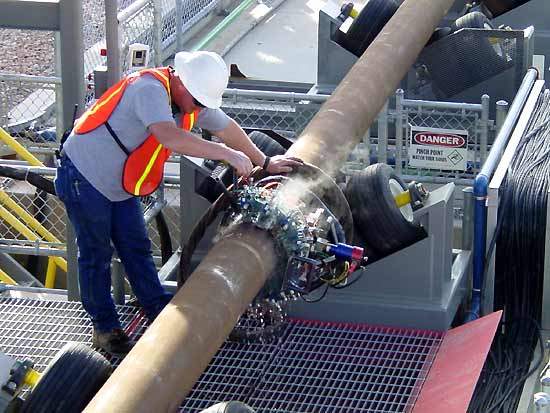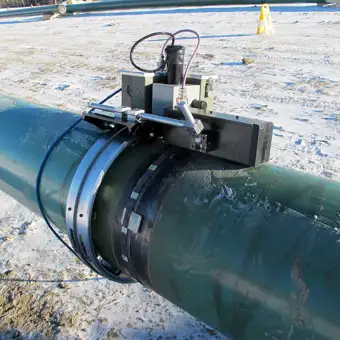Pipeline Welding Inspection: Ensuring Safety And Security and Top Quality in Every Weld
Pipeline Welding Inspection: Ensuring Safety And Security and Top Quality in Every Weld
Blog Article
Advanced Strategies in Pipeline Welding Inspection: Advancements and Technologies for Enhanced Precision and Dependability in Weld Analysis
The landscape of pipeline welding assessment is undertaking a substantial change, driven by advanced techniques that guarantee to enhance both accuracy and reliability in weld assessments. Technologies such as computerized assessment systems and advanced imaging technologies are redefining conventional practices, while non-destructive screening techniques make sure product stability is kept. As these innovations evolve, they not only raise problem detection prices but additionally allow a lot more efficient upkeep strategies. Nonetheless, the implications of these innovations prolong beyond prompt benefits, increasing vital questions about future practices and requirements in the sector.

Significance of Weld Examination
Making sure the honesty of pipe welds is vital to the overall security and dependability of commercial systems. Welds act as the structural foundation of pipelines, which deliver a selection of liquids under varying stress. Flaws in welding can bring about devastating failures, resulting in not just significant financial losses but additionally possible environmental calamities and threats to public safety. For that reason, extensive assessment of welds is important to the lifecycle of pipe facilities.
The value of weld examination extends past plain compliance with regulative requirements. It acts as a positive action to identify and remedy flaws, such as incomplete blend, porosity, or cracks, before they rise into major problems. Effective inspection methods additionally contribute to the durability of pipes, reducing maintenance prices and enhancing operational performance.
Furthermore, detailed weld assessments foster trust among stakeholders, consisting of governing bodies, financiers, and the areas served by these pipes. By guaranteeing that all welds satisfy the needed standards, companies can minimize risks and promote their track records. In recap, weld inspection is important not only for functional stability but additionally for the wider effects it holds for safety and environmental stewardship.
Automated Examination Equipments
The assimilation of automatic assessment systems in pipe welding has reinvented the approach to making certain weld quality and integrity. These systems use advanced robotics and man-made intelligence to carry out inspections that are not just quicker but likewise much more regular than traditional methods. Automated systems can cover substantial lengths of pipes effectively, catching data that human assessors could forget because of tiredness or ecological conditions.
Among the key advantages of automatic evaluation systems is their capability to run in unsafe environments, decreasing the risk to human examiners. They utilize various non-destructive screening (NDT) strategies, such as ultrasonic screening and magnetic particle evaluation, to analyze weld honesty without endangering the structure. The information accumulated is processed in real-time, enabling for prompt comments and prompt corrective activities when problems are determined.
In addition, automated systems promote the standardization of evaluation processes, making certain that each weld is examined versus constant standards. This not just improves the reliability of outcomes however likewise simplifies compliance with governing requirements. As markets remain to focus on safety and security and operational performance, the role of automated assessment systems in pipeline welding will unquestionably increase, leading the means for much more innovative top quality guarantee approaches.
Advanced Imaging Technologies
Frequently used in contemporary pipe welding examinations, advanced imaging technologies have dramatically improved the capability to spot and examine weld issues. Techniques such as electronic radiography, calculated tomography, and thermographic imaging supply examiners with high-resolution pictures that disclose sub-surface imperfections and structural incongruities that might be undetectable to the nude eye.
This Bonuses leads to quicker examinations and boosted accuracy in determining important defects. Computed tomography, on the other hand, supplies three-dimensional imaging, allowing examiners to imagine complicated geometries and examine the integrity of welds from numerous angles.
Thermographic imaging employs infrared technology to detect variations in temperature, determining areas of potential weak point or tension within the weld. These innovative imaging innovations not only boost problem detection prices but also reduce the time and resources needed for pipe assessments. As an outcome, they play an essential role in preserving pipeline safety and security and integrity, ensuring conformity with sector standards while reducing functional risks.
Non-Destructive Evaluating Approaches
Using various techniques, non-destructive testing (NDT) approaches are crucial in pipeline welding examinations, permitting the evaluation of weld stability without compromising the material's architectural stability. NDT encompasses a variety of approaches, consisting of ultrasonic screening (UT), radiographic testing (RT), magnetic particle testing (MT), and dye penetrant screening (PT) Each approach has distinctive advantages and applications depending upon the specific demands of the inspection.
Ultrasonic screening makes use of high-frequency sound waves to spot inner problems, offering specific dimensions of weld thickness and integrity. Pipeline Welding Inspection. Radiographic testing utilizes X-rays or gamma rays to create pictures of the weld, revealing inner flaws that might not be visible on the surface. Magnetic particle screening works for discovering surface area and near-surface suspensions in ferromagnetic products, while color penetrant screening highlights surface area cracks by making use of a tinted dye
Including these NDT techniques right into pipe welding assessments enhances the precision and integrity of weld assessments, ensuring that potential failings are identified early. As industries demand greater requirements for safety and security and performance, the role of NDT in keeping the stability of bonded structures remains to be critical in pipe building and maintenance.

Future Patterns in Weld Assessment
As we seek to the future of weld evaluation, advancements in technology are positioned to transform the methods employed for examining pipeline stability. The assimilation of fabricated intelligence (AI) and equipment discovering in examination processes is anticipated to enhance the precision of defect discovery and predictive maintenance. These modern technologies enable for real-time data evaluation, allowing inspectors to Pipeline Welding Inspection recognize prospective concerns prior to they escalate right into considerable troubles.
In addition, using drones geared up with sophisticated imaging systems is gaining traction. These airborne assessments can cover large areas swiftly, catching high-resolution photos and information that can be assessed for defects in hard-to-reach locations. This not just boosts safety and security yet likewise increases efficiency in the assessment procedure.
In addition, the advancement of clever sensing units installed in pipe systems supplies the potential for constant tracking. These sensing units can identify modifications in pressure, temperature level, and vibrations, supplying important understandings into the health of the welds with time.

Final Thought
Finally, the integration of advanced methods in pipeline welding examination dramatically boosts the precision and integrity of weld evaluations. Developments such as automated assessment systems, progressed imaging innovations, and non-destructive testing approaches play a vital function in improving defect discovery prices and promoting proactive maintenance techniques. As these technologies remain to progress, they will certainly even more make sure the safety and performance of pipeline systems, ultimately adding to the go integrity of crucial framework.

Report this page